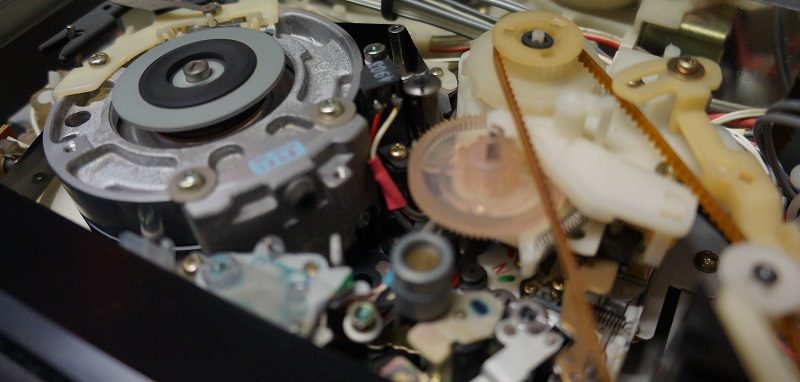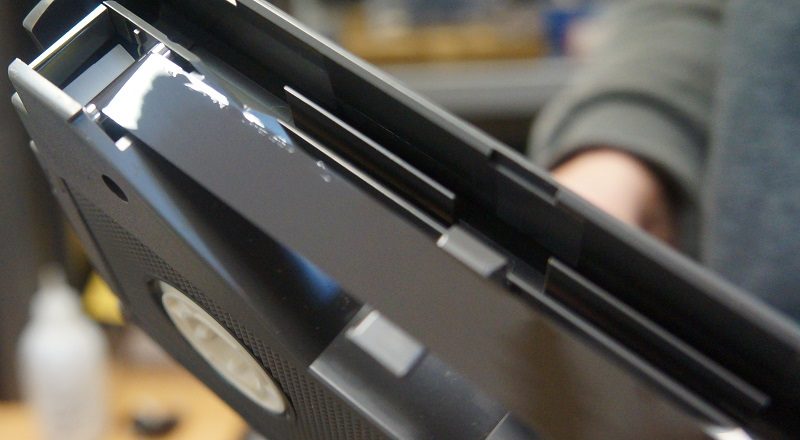We are now used to living in a born-digital environment, but the transition from analogue to digital technologies did not happen overnight. In the late 1970s, early digital audio recordings were made possible by a hybrid analogue/digital system. It was composed by the humble transport and recording mechanisms of the video tape machine, and a not so humble PCM (pulse-code-modulation) digital processor. Together they created the first two-channel stereo digital recording system.

The first professional-use digital processing machine, made by SONY, was the PCM 1600. It was introduced in 1978 and used a U-matic tape machine. Later models, the PCM 1610/ 1630, acted as the first standard for mastering audio CDs in the 1980s. SONY employee Toshitada Doi, whose impressive CV includes the development of the PCM adaptor, the Compact Disc and the CIRC error correction system, visited recording studios around the world in an effort to facilitate the professional adoption of PCM digital technologies. He was not however welcomed with open arms, as the SONY corp. website explains:
'Studio engineers were opposed to digital technology. They criticized digital technology on the grounds that it was more expensive than analogue technology and that it did not sound as soft or musical. Some people in the recording industry actually formed a group called MAD (Musicians Against Digital), and they declared their position to the Audio Engineering Society (AES).'
Several consumer/ semi-professional models were marketed by SONY in the 70s and 80s, starting with the PCM-1 (1977). In a retro-review of the PCM-F10 (1981), Dr Frederick J. Bashour explains that
'older model VCRs often worked better than newer ones since the digital signal, as seen by the VCR, was a monochrome pattern of bars and dots; the presence of modern colour tweaking and image compensation circuits often reduced the recording system's reliability and, if possible, were turned off.'
Why did the evolution of an emerging digital technology stand on the shoulders of what had, by 1981, become a relatively mature analogue technology? It all comes down to the issue of bandwidth. A high quality PCM audio recording required 1-1.5 MHz bandwidth, which is far greater than a conventional analogue audio signal (15-20KHz). While this bandwidth was beyond the scope of analogue recording technology of the time, video tape recorders did have the capacity to record signals with higher bandwidths.
If you have ever wondered where the 16 bit/ 44 Khz sampling standard for the CD came from, it was because in the early 1980s, when the CD standard was agreed, there was no other practical way of storing digital sound than by a PCM Converter & video recorder combination. As the wikipedia entry for the PCM adaptor explains, 'the sampling frequencies of 44.1 and 44.056 kHz were thus the result of a need for compatibility with the 25-frame (CCIR 625/50 countries) and 30-frame black and white (EIAN 525/60 countries) video formats used for audio storage at the time.' The sampling rate was adopted as the standard for CDs and, unlike many other things in our rapidly changing technological world, it hasn't changed since.
The fusion of digital and analogue technologies did not last long, and the introduction of DAT tapes in 1987 rendered the PCM digital converters/ video tape system largely obsolete. DAT recorders basically did the same job as PCM/ video but came in one, significantly smaller, machine. DAT machines had the added advantage of being able to accept multiple sampling rates (the standard 44.1 kHz, as well as 48kHz, and 32kHz, all at 16 bits per sample, and a special LP recording mode using 12 bits per sample at 32 kHz for extended recording time).
Problems with migrating early digital tape recordings
There will always be the risk with any kind of magnetic tape recordings that there won't be enough working tape machines to playback the material recorded on them in the future. As spare parts become harder to source, tapes with worn out transport mechanisms will simply become inoperable. We are not quite at this stage yet, and at Greatbear we have plenty of working U-matic, Betamax and VHS machines so don't worry too much! Machine obsolescence is however a real threat facing tape-based archives.
Such a problem comes into sharp relief when we consider the case of digital audio recordings made on analogue video tape machines. Audio recordings 'work' the tape transport in a far more vigorous fashion than your average domestic video tape user. It may be rewound and fast-forwarded more often, and in a professional environment may be in constant use, thus leading to greater wear and tear.
Those who chose to adopt digital early and made recordings on tape will have marvelled at the lovely clean recordings and the wonders of error correction technology. As a legacy format however, tape-based digital recordings are arguably more at risk than their analogue counterparts. They are doubly compromised by fragility of tape, and the particular problems that befall digital technologies when things go wrong.

Because it is a digital recording, this has led to substantial problems with the transfer, namely that large sections of the recording simply 'drop out.' In instances such as these, where the tape itself has been damaged, analogue recordings on tape are infinitely more recoverable than digital ones. Dr W.C. John Van Bogart explains that
'even in instances of severe tape degradation, where sound or video quality is severely compromised by tape squealing or a high rate of dropouts, some portion of the original recording will still be perceptible. A digitally recorded tape will show little, if any, deterioration in quality up to the time of catastrophic failure when large sections of recorded information will be completely missing. None of the original material will be detectable in these missing sections.'
This risk of catastrophic, as opposed to gradual loss of information on tape based digital media, is what makes these recordings particularly fragile and at risk. What is particularly worrying about digital tape recordings is they may not show any external signs of damage until it is too late. We therefore encourage individuals, recording studios and memory institutions to assess the condition of their digital tape collections and take prompt action if the recorded information is valuable.
The story of PCM digital processors and analogue tapes gives us a fascinating window into a time when we were not quite analogue, but not quite digital either, demonstrating how technologies co-evolve using the capacities of what is available in order to create something new.
For our PCM audio on video tape transfer services please follow this link: greatbear - PCM audio on video tape


[…] album is also among the first to adopt digital recording technology, specifically the PCM-1600, which was Sony’s first (and technically “the first”) […]
I was given a VHS tape cassette by the late great Paul Butterfield. I was his Tour Manager in 1982 and we did a live recording at a night club in San Jose, California on May 10, 1982. It was recorded by Bodacious Audio on Sony Digital Mastering System PCM10 according to the label on the cassette. I would like to know if I can have this content transferred to CD, or mp3 or any format.
I have this setup still
Sony sponsored an early 80s concert tour on which I was part of the production staff. As a perk, they allowed us to purchase Sony gear at reduced cost and offered to ship them to us so we didn’t have to weather the entire Customs thingie. In addition to some upgrades to my home stereo, I purchased a PCM-F1, and for the better part of that decade (until I purchased a Panasonic SV-255) used it to record live shows directly from the FOH console. Up until that time, I was recording on a high-end cassette deck… but the difference in quality was astonishing.
In the late 90s, with the increased ease of hard disc recording to uncompressed AIFF/WAV format (and eventually FLAC), I undertook the long, linear task of transferring the (possibly deteriorating) magnetic tape stock. I had not heard many of the recordings in over a decade, but was ecstatic to hear how good they sounded.
The only thing I ever wondered was if there was a way to bypass the analog RCA outputs and make the transfer “digitally direct”. I searched for a possible hack to the PCM-F1 that would add a digital audio out (TOSLINK/coaxial?) but never found one. Still, I am in no way unhappy with the results. It was a truly magnificent machine and – at the time – an absolute paradigm shift for audio recordings.